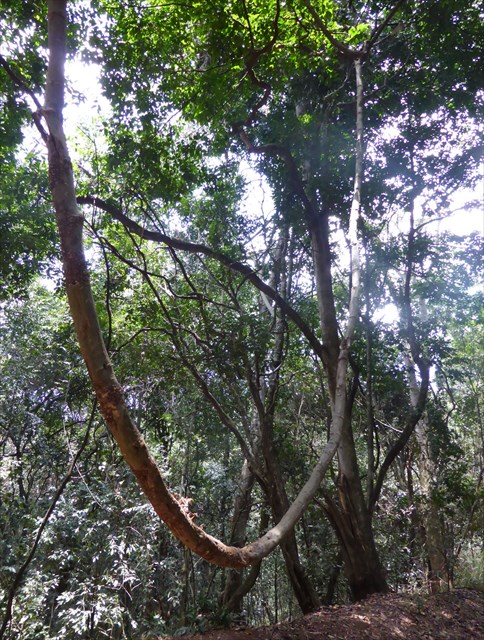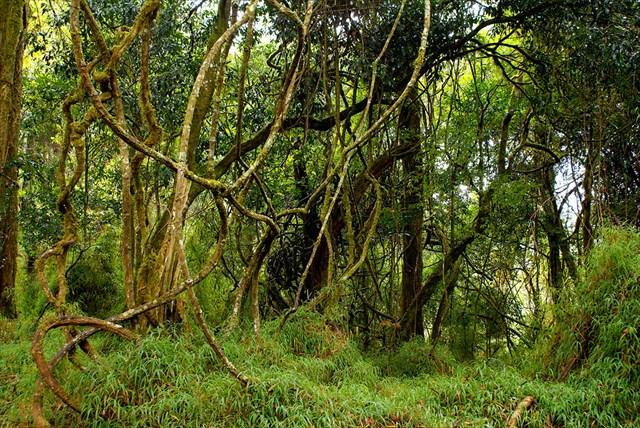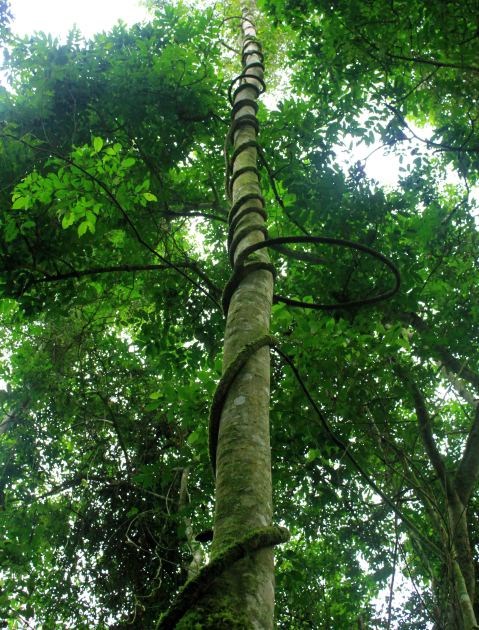Karura Forest #25: Lone Liana
 The cache, a small black-taped tablet tube, is hidden between the buttressed roots of a small tree about 2m above the Mau Mau trail (which runs from Junction 12a in the west along the Karura river valley to to Junction 21 in the east of the forest) on the side facing the huge lone liana dangling over the trail.
The cache, a small black-taped tablet tube, is hidden between the buttressed roots of a small tree about 2m above the Mau Mau trail (which runs from Junction 12a in the west along the Karura river valley to to Junction 21 in the east of the forest) on the side facing the huge lone liana dangling over the trail.
Update 8 March 2015: the liana has gone - chopped down for some unknown reason - but the cache is still there!
For background information on Karura Forest including access, fees, opening times, features, a detailed trail map and useful links, see GC4PD3V Karura Forest #1: Intro, Info & Entry.
Creepers, vines, and lianas (woody vines) are abundant in the canopy and make up a significant proportion of the vegetation in tropical rainforests. There are over 2,500 species of vines from about 90 families. They range from small, indiscrete vines that grow against the tree to giant lianas thick as trees that seemingly hang in the middle of the forest independent of trees.
90% of the world's vine species grow in tropical moist deciduous forest and rainforests and lianas are a type of various species of climbing vine found throughout these forests. They have thick, woody stems and come in various lengths (up to 3,000 ft) and varying shapes. They begin life on the forest floor but depend on trees for support as they climb upwards towards the canopy and the sunlight they need for survival. They do this by attaching themselves to trees with sucker roots or tendrils and growing with the young sapling, or they climb by winding themselves round the tree's trunk.
When they reach the top of the canopy they often spread to other trees or wrap themselves  around other lianas. This network of vines gives support against strong winds to the shallow-rooted, top-heavy trees. However, when one tree falls several others may be pulled down also.
around other lianas. This network of vines gives support against strong winds to the shallow-rooted, top-heavy trees. However, when one tree falls several others may be pulled down also.
Lianas include rattan palms, philodendron and Strychnos toxifera (from which the deadly poison strychnine is obtained). Rattans, the Asian lianas, have thorny stems and can reach heights of 650 feet (200 m). They are used to make a variety of things including baskets, ropes and wicker furniture. It also produces large, edible fruits - a favorite of primates.
The term 'liana' (like 'tree' or 'shrub') is not a taxonomic grouping, but simply a description of the way the plant grows – and lianas may be found in many different plant families. One way of distinguishing lianas from trees and shrubs is based on the stiffness (specifically, the Young's modulus) of various parts of the stem. Trees and shrubs have young twigs and smaller branches which are quite flexible and older growth such as trunks and large branches which are stiffer. In contrast a liana often has stiff young growths and older growth, at the base of the stem, which is more flexible.
 Lianas compete intensely with trees for sunlight, water and soil nutrients, greatly reducing tree growth and reproduction, greatly increasing tree mortality, preventing tree seedlings from establishing, and altering the course of regeneration in forests. Lianas also provide access routes (bridges) in the forest canopy for many arboreal animals, including ants and many other invertebrates, lizards, rodents, sloths, monkeys, and lemurs. Lianas also provide support for trees when strong winds blow. However, they may be destructive in that when one tree falls, the connections made by the lianas may cause many other trees to fall.
Lianas compete intensely with trees for sunlight, water and soil nutrients, greatly reducing tree growth and reproduction, greatly increasing tree mortality, preventing tree seedlings from establishing, and altering the course of regeneration in forests. Lianas also provide access routes (bridges) in the forest canopy for many arboreal animals, including ants and many other invertebrates, lizards, rodents, sloths, monkeys, and lemurs. Lianas also provide support for trees when strong winds blow. However, they may be destructive in that when one tree falls, the connections made by the lianas may cause many other trees to fall.
As noted by Charles Darwin because lianas are supported by other plants, they may conserve resources that other plants must allocate to the development of structure and use them instead for growth and reproduction. In general, lianas are detrimental to the trees that support them: growth rates are lower for trees with lianas, they directly damage hosts by mechanical abrasion and strangulation, render hosts more susceptible to ice and wind damage, and increase the probability that the host tree falls. Lianas also make the canopy of trees more accessible to animals which eat leaves. Because of these negative effects, trees which remain free of lianas are at an advantage. As a result some species have evolved characteristics which help them avoid or shed lianas - many palm and tree ferns regularly drop fronds, while other trees may lose limbs to rid themselves of lianas.
In 2005, researchers made some surprising discoveries about lianas. Using data from 69 tropical forests worldwide, they found that liana abundance is correlated negatively with precipitation and positively with seasonality, a pattern precisely the opposite of most other plant types. It is believed that the deep root and efficient vascular systems of lianas enable them to suffer less water stress during seasonal droughts while many competitors are dormant, giving lianas a competitive advantage during the dry season. When testing this hypothesis in central Panama, it was found that lianas grew approximately 7 times more in height than trees during the dry season but only twice as much during the wet season.'
during seasonal droughts while many competitors are dormant, giving lianas a competitive advantage during the dry season. When testing this hypothesis in central Panama, it was found that lianas grew approximately 7 times more in height than trees during the dry season but only twice as much during the wet season.'
Lianas have been used for the construction of precarious suspension bridges across steep river gorges in rainforests around the world - see the Gallery for photos of these.
See also here and here for amazing short videos of African Pygmies constructing a liana bridge (c1930s).